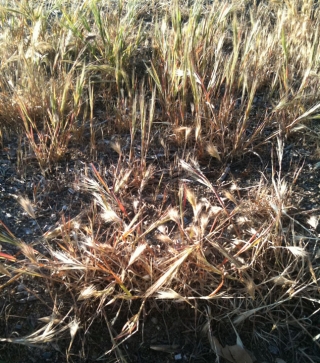There is a lot more to working with aggression cases than mastering methods and techniques.
The Killers that Surround us

There’s a woman who walks her black Lab around the park early in the mornings. As we passed them with our dogs the other day, my friend informed me that the poor dog was recovering from his third round of surgery. He’d almost died. The cause? A tiny, insignificant-looking bit of nastiness called a “foxtail.”
Foxtails aren’t technically plants, but “diasporas” or “plant dispersal units.” They’ve got a hardened tip and a bunch of barbs that point away from the tip, and are so named because they resemble the tail of a fox. The barbs cause the foxtail to cling to fur, and the movement of the dog allows the foxtail to burrow into the fur. Unfortunately, especially in long-haired dogs (the only kind we ever seem to have), the foxtail can work its way into the skin and become irreversibly lodged.
The Lab in question had inhaled a foxtail through his nose, which had somehow worked its way up his nasal passages and down his throat, having caused a serious infection before the problem was discovered. With surface lesions, the foxtail is removed and the area disinfected and bandaged, but a foxtail that has worked its way into the skin can cause serious infection and worse. Depending on the location, the vet may prescribe antibiotics and allow the foxtail to encyst or degrade, or, in the case of imminent organ damage, choose to perform surgery. Foxtails embedded in the nostrils can cause intense distress to dogs, and in rare cases, can migrate to the brain. Foxtails in the ear canal can puncture the eardrum and enter the middle ear, causing hearing loss. They can even get under an eyelid.
Of course, detection and early removal is key. Watch where your dog is walking and sticking his nose during outings. Check between paw pads regularly, as well as around the ears and nostrils. Regular brushing, especially for long-haired dogs, can dislodge foxtails before they can attach. Take note if you see your dog displaying unusual behavior such as sneezing or pawing at his nose or ears.
The hillsides of the rural desert area where we live are absolutely blanketed in foxtails. And each year, the spiky suckers inevitably show up in the large area in back of our house that is frequented by our dogs. I just spent the better part of an hour pulling bunch after bunch out by the roots, as they seemingly sprung up overnight after all the recent rains. My husband saw me yanking at them as he headed out to work, and commented that it wouldn’t help my already aching lower back. But they’d already started drying out, turning from green to yellow, and that’s when they become potentially deadly. I’ve got ice on my back as I type this, but I also have peace of mind that, at least for now, hundreds less of the deadly killers are residing in my dog’s favorite hangout spots.
If you live in a part of the country where foxtails are not an issue, good for you. If you do have them where you live, don’t get lax in your vigilance. It only takes one little foxtail to potentially kill your dog. That may sound dramatic, but it’s also true; think of them as tiny little killers you’re taking out before they take out your dog.
Find me on Facebook: https://facebook.com/NicoleWildeAuthor, follow me on Twitter @NicoleWilde, and visit my Wilde About Dogs blog at www.wildewmn.wordpress.com.










